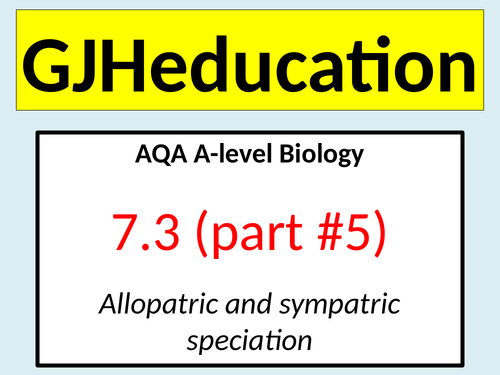



This fully-resourced lesson explores how new species arise when changes in the gene pool of two populations prevents members from interbreeding and producing fertile offspring. The engaging PowerPoint and accompanying resources have been designed to cover the fifth part of point 7.3 of the AQA A-level Biology specification which states that students should be able to describe allopatric and sympatric speciation.
The lesson begins by using the example of a hinny, which is the hybrid offspring of a horse and a donkey, to challenge students to recall the biological classification of a species. Moving forwards, students are introduced to the idea of speciation and the key components of this process, such as isolation and selection pressures, are covered and discussed in detail. Understanding and prior knowledge checks are included throughout the lesson to allow the students to not only assess their progress against the current topic but also to make links to earlier topics in the specification. Time is taken to look at the details of allopatric speciation and how the different mutations that arise in the isolated populations and genetic drift will lead to genetic changes. The example of allopatric speciation in wrasse fish because of the isthmus of Panama is used to allow the students to visualise this process. The final part of the lesson considers sympatric speciation and again a wide variety of tasks are used to enable a deep understanding to be developed.
Get this resource as part of a bundle and save up to 38%
A bundle is a package of resources grouped together to teach a particular topic, or a series of lessons, in one place.
AQA A-level Biology Topic 7: Genetics, populations, evolution and ecosystems
This bundle contains 15 fully-resourced and detailed lessons that have been designed to cover the content of topic 7 of the AQA A-level Biology specification which concerns genetics, populations, evolution and ecosystems. The wide range of activities included in each lesson will engage the students whilst the detailed content is covered and the understanding and previous knowledge checks allow them to assess their progress on the current topic as well as challenging them to make links to other related topics. Most of the tasks are differentiated to allow differing abilities to access the work and be challenged. The following sub-topics are covered in this bundle of lessons: * The use of genetic terminology * The inheritance of one or two genes in monohybrid and dihybrid crosses * Codominant and multiple alleles * The inheritance of sex-linked characteristics * Autosomal linkage * Epistasis as a gene interaction * The use of the chi-squared test * Calculating allele frequencies using the Hardy-Weinberg principle * Causes of phenotypic variation * Stabilising, directional and disruptive selection * Genetic drift * Allopatric and sympatric speciation * Species, populations, communities and ecosystems * Factors affecting the populations in ecosystems * Estimating the size of a population using randomly placed quadrats, transects and the mark-release-recapture method * Conservation of habitats frequently involves the management of succession This is one of the 8 topics which have to be covered over the length of the 2 year course and therefore it is expected that the teaching time for this bundle will be in excess of 2 months If you want to see the quality of the lessons before purchasing then the lessons on codominant and multiple alleles, epistasis and phenotypic variation are free resources to download
Topic 7.3: Evolution may lead to speciation (AQA A-level Biology)
Each of the 4 lessons included in this bundle are fully-resourced and have been designed to cover the content as detailed in topic 7.3 (Evolution may lead to speciation) of the AQA A-Level Biology specification. The specification points that are covered within these lessons include: * Phenotypic variation within a species * The effects of stabilising, directional and disruptive selection * The importance of genetic drift in causing changes in allele frequency * Allopatric and sympatric speciation The lessons have been written to include a wide range of activities and numerous understanding and prior knowledge checks so students can assess their progress against the current topic as well as be challenged to make links to other topics within this module and earlier modules If you would like to see the quality of the lessons, download the phenotypic variation lesson which is free
Something went wrong, please try again later.
This resource hasn't been reviewed yet
To ensure quality for our reviews, only customers who have purchased this resource can review it
Report this resourceto let us know if it violates our terms and conditions.
Our customer service team will review your report and will be in touch.